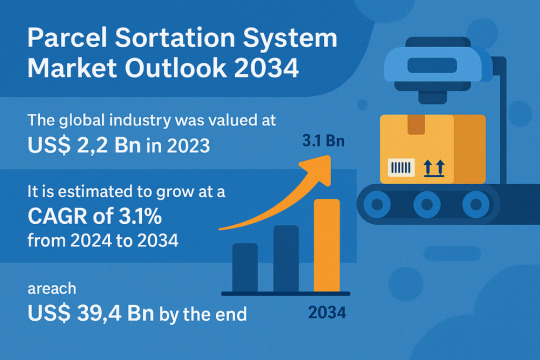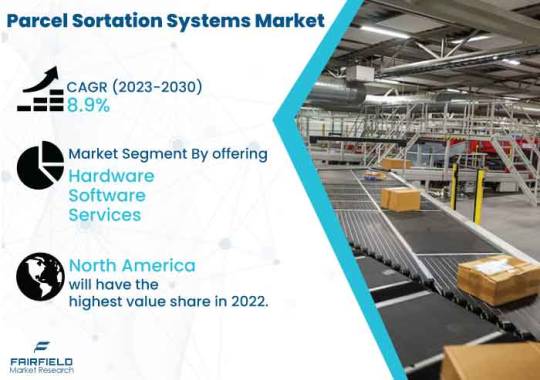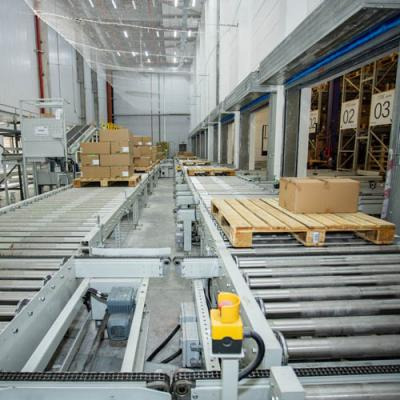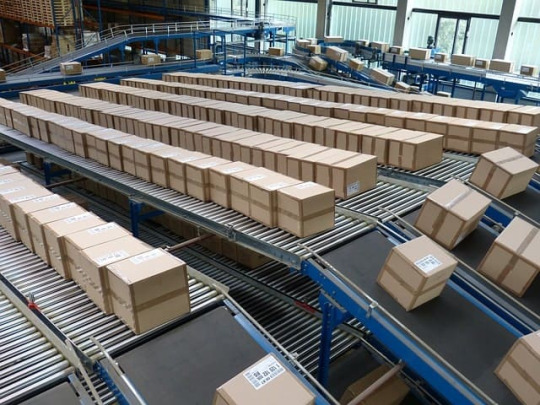#Parcel Sortation Systems
Explore tagged Tumblr posts
Text
Parcel Sortation Systems Market Growth Scenario (2024-2030)
https://www.htfmarketintelligence.com/report/global-parcel-sortation-systems-market
0 notes
Text
https://www.htfmarketintelligence.com/report/global-parcel-sortation-systems-market
0 notes
Text
Parcel Sortation Systems: Driving the Future of Automated Logistics

The global parcel sortation system market was valued at USD 2.2 billion in 2023 and is projected to grow to USD 3.1 billion by 2034, representing a compound annual growth rate (CAGR) of 3.1% over the forecast period (2024–2034). Parcel sortation systems are automated solutions designed to detect, sort, and route various types of packages based on predefined criteria such as size, weight, destination, or barcode data. These systems play a critical role in modern logistics, warehousing, e-commerce, and airport operations by optimizing order fulfillment and improving operational efficiency.
According to industry analysts, the steady growth of the parcel sortation system market is driven primarily by the surge in online shopping and the rapid adoption of automated sorting technologies. Leading vendors are increasingly integrating AI-driven analytics, machine learning algorithms, and advanced robotics to fully automate the sortation process. These innovations not only enhance throughput rates but also significantly reduce labor costs and order errors.
Market Drivers & Trends
Surge in Online Shopping: E-commerce giants and retail players are witnessing unprecedented package volumes. For example, Amazon Logistics alone shipped approximately 4.8 billion packages in 2022, averaging over 13 million deliveries per day. This boom in online retail necessitates scalable sortation infrastructures to process high volumes with accuracy and speed.
Adoption of Automated Parcel Sorting Robots: The transition from manual sorting to robotic and AI-powered solutions is accelerating. Automated guided vehicles (AGVs), robotic arms, and crossbelt sorters enhance the flexibility and reliability of warehouse and distribution centers.
Labor Shortages & Cost Reduction: Rising labor costs and workforce scarcity are prompting companies to invest in automation. Automated sortation systems offer long-term operational savings and can be redeployed to perform higher-value tasks.
Integration of AI & Data Analytics: Predictive maintenance, real-time monitoring, and dynamic routing are now feasible thanks to data-driven platforms. These systems help preempt equipment failures and optimize workflow.
Latest Market Trends
Hybrid Sorting Solutions: Combining multiple sorter types (e.g., crossbelt, tilt-tray, and pop-up sorters) in a single system to handle diverse parcel dimensions and fragility levels.
Last-Mile Optimization: Sortation systems integrated with route-planning software to accelerate delivery times and reduce transportation costs.
Cloud-Based Control Platforms: SaaS offerings that allow remote monitoring and performance analytics of sortation assets across multiple sites.
Sustainability Initiatives: Energy-efficient conveyors and recyclable sorter components are gaining traction in response to corporate ESG commitments.
Key Players and Industry Leaders Major vendors in the parcel sortation system market include:
Daifuku Co. Ltd.: Pioneer in automated warehouse solutions, with recent investments in ML-based sortation intelligence.
Dematic: Offers modular sortation lines and turnkey warehouse automation services.
GreyOrange: Known for its AI-driven Butler robotics and Rian sorter systems.
Bastian Solutions, LLC: Specializes in conveyors, sortation, and integration services.
Siemens Logistics GmbH: Provides end-to-end sortation solutions, from barcode scanners to crossbelt sorters.
Beumer Group: Developer of the PSL crossbelt sorter and energy-optimized automated systems.
Honeywell International Inc.: Integrates voice-guided picking with automated sortation for e-commerce fulfillment.
Unlock crucial data and key findings from our Report in this sample - https://www.transparencymarketresearch.com/sample/sample.php?flag=S&rep_id=62082
Recent Developments
January 2024: Viettel Post deployed 160 LiBiao ‘Mini Yellow’ autonomous guided robots at its Hanoi distribution hub, resulting in a 30% increase in sorting throughput and 20% reduction in sorting errors.
February 2024: Daifuku Intralogistics India showcased its fully automated warehouse solutions at LogiMAT India 2024, featuring virtual reality demonstrations of sorting transfer vehicles and AS/RS integration.
August 2023: Falcon Autotech partnered with DTDC Express to automate parcel sorting at DTDC’s 1.7 million sq. ft. super hub in Chennai, deploying high-speed crossbelt sorters capable of processing 25,000 parcels per hour.
Market Opportunities
Expansion in Emerging Economies: Asia Pacific and Latin America present significant growth potential as e-commerce adoption accelerates and infrastructure investments increase.
SME-Oriented Solutions: Scalable, cost-effective sortation modules tailored for small-to-mid-sized logistics providers.
Aftermarket Services: Remote monitoring, predictive maintenance, and training services for optimized system uptime.
Collaboration with Last-Mile Delivery Providers: Integrating sortation systems directly with delivery fleet management platforms to close the logistics loop.
Future Outlook Looking ahead to 2034, the parcel sortation system market is expected to benefit from:
5G-enabled IoT Connectivity: Real-time asset tracking within warehouses and distribution centers.
Autonomous Mobile Robots (AMRs): Flexible sortation workflows that adapt to changing parcel profiles and order mix.
Blockchain for Provenance: Secure, immutable records of parcel movement to meet regulatory requirements, especially in pharmaceuticals.
Augmented Reality (AR) for Maintenance: Technician support through AR overlays to reduce downtime during repairs.
Market Segmentation
By Offering:
Hardware: Conveyors, sensors, scanners, sorters.
Software: Warehouse execution systems, sortation control software.
Services: Implementation, training, maintenance.
By Type:
Case Sorters
Pop-up Sorters
Shipping Carton Sorters
Pivoting Arm Sorters
Pusher Sorters
Tilt Tray Sorters
Crossbelt Sorters
Pouch Sorters
Others
By End-Use:
Logistics
E-commerce
Airports
Pharmaceuticals
Food & Beverages
Others (Healthcare, etc.)
Regional Insights
North America: Leading region with the highest market share in 2023, driven by consumer demand for same-day/next-day delivery and significant automation investments in U.S. and Canada.
Europe: Strong growth owing to high e-commerce penetration (82% of U.K. consumers made online purchases in 2021) and the adoption of AI/ML for sortation optimization.
Asia Pacific: Emerging distribution hubs in China, India, and ASEAN countries are investing in modern fulfillment centers equipped with advanced sortation technologies.
Middle East & Africa: Growing retail infrastructure and government initiatives to enhance supply chain resilience.
South America: Increasing e-commerce activities in Brazil and Argentina creating demand for small-scale sortation solutions.
Why Buy This Report?
Comprehensive Coverage: Detailed quantitative and qualitative analysis including market drivers, restraints, opportunities, and key trends.
Strategic Insights: In-depth profiles of 15+ leading players, including their product portfolios, financial overviews, and recent developments.
Robust Forecasting: Market projections through 2034, with historical data (2020–2022) to contextualize growth trajectories.
Actionable Recommendations: Market entry strategies, investment opportunities, and aftermarket service models.
Customizable Data: Interactive PDFs and Excel workbooks with segment-level data and regional break-downs.
About Transparency Market Research Transparency Market Research, a global market research company registered at Wilmington, Delaware, United States, provides custom research and consulting services. Our exclusive blend of quantitative forecasting and trends analysis provides forward-looking insights for thousands of decision makers. Our experienced team of Analysts, Researchers, and Consultants use proprietary data sources and various tools & techniques to gather and analyses information. Our data repository is continuously updated and revised by a team of research experts, so that it always reflects the latest trends and information. With a broad research and analysis capability, Transparency Market Research employs rigorous primary and secondary research techniques in developing distinctive data sets and research material for business reports. Contact: Transparency Market Research Inc. CORPORATE HEADQUARTER DOWNTOWN, 1000 N. West Street, Suite 1200, Wilmington, Delaware 19801 USA Tel: +1-518-618-1030 USA - Canada Toll Free: 866-552-3453 Website: https://www.transparencymarketresearch.com Email: [email protected]
0 notes
Text
Parcel Sortation Systems Market - Global Growth, Share, Trends, Demand and Analysis Report Forecast 2030

Global parcel sortation systems market is poised for unprecedented growth, driven by key technological advancements and the surge in eCommerce activities. With increasing demands for faster, more efficient deliveries, businesses are turning to innovative solutions to meet consumer expectations and optimize their logistics operations. A recent report provides insights into the trends, growth determinants, barriers, and regional outlook shaping the parcel sortation systems market from 2018 to 2030.
Key Trends Fueling Growth:
Advanced Sensor Technologies: The market anticipates a surge in demand for advanced sensor technologies like barcode scanners and high-resolution cameras, enhancing parcel identification accuracy and reducing sorting errors.
Precise parcel identification minimizes mistakes during the sorting process, ensuring each package reaches its destination accurately.
Real-time Data Analytics: Real-time data analytics facilitates dynamic route optimization, enabling sorting systems to adjust routes in real-time for maximum productivity and on-time delivery.
Dynamic route optimization enhances operational efficiency, ensuring timely delivery and customer satisfaction.
Dominance of Linear Sortation Systems: In 2023, linear sortation systems dominated the industry, boasting high-order precision and accurate diverters. These systems play a critical role in ensuring sorting accuracy and error-free deliveries.
Accurate diverters and linear movement contribute to efficient sorting, reducing the likelihood of misplacements.
Market Insights and Opportunities:
Software Segment Dominance: The software segment is projected to dominate the parcel sortation systems market, facilitating barcode scanning and image recognition for improved parcel identification accuracy.
Error-free sorting and increased order correctness depend on advanced software solutions.
Rapid Growth in Food and Beverage Sector: The food and beverage category emerges as the fastest-growing market for parcel sortation systems, driven by the need to handle sensitive or fragile products with care.
Parcel sortation systems equipped with features for gentle handling reduce the risk of product damage.
North America's Market Leadership: North America is expected to account for the largest share of the global parcel sortation systems market, fueled by the region's emphasis on technical innovation and adoption of cutting-edge technologies.
Advanced logistics infrastructure and consumer demand for timely deliveries drive market growth in North America.
Growth Determinants and Barriers:
Remarkable Growth of eCommerce: The proliferation of eCommerce fuels the demand for parcel sortation systems, essential for handling growing shipments and ensuring prompt and precise sorting.
Parcel sortation systems optimize last-mile delivery, meeting consumer expectations for prompt and reliable service.
High Initial Investments: Implementing parcel sortation systems requires significant capital investment, posing a barrier for many businesses, particularly smaller ones with constrained budgets.
Large initial investment costs may deter SMEs from adopting automated sorting solutions.
Integration Challenges with Existing Systems: Integrating parcel sortation systems with diverse IT infrastructures poses technological challenges, potentially disrupting workflow efficiency.
Compatibility issues between automated sorting solutions and legacy systems may hinder seamless integration.
Emerging Trends and Opportunities:
Rise of AI and ML: AI and ML technologies enhance package sorting accuracy through large-scale data analysis, minimizing placement errors and optimizing sorting routes dynamically.
Real-time data analysis and machine learning algorithms improve operational efficiency and enhance customer satisfaction.
Increasing Robotics and Automation: Robotics and automation technologies enable higher-speed parcel sorting, particularly during peak seasons, ensuring continuous 24/7 operations to meet global delivery expectations.
Automation streamlines sorting processes, enabling businesses to handle more parcels efficiently.
Sustainable Solutions: Growing environmental consciousness presents an opportunity for companies to develop and market eco-friendly parcel sorting systems, prioritizing energy efficiency and environmental sustainability.
Environmentally friendly solutions cater to the increasing demand for sustainable practices in logistics operations.
Regional Outlook:
North America's Dominance: North America leads the parcel sortation systems market, driven by the region's advanced logistics infrastructure and consumer demand for dependable deliveries.
Contemporary distribution centers and transportation networks facilitate the implementation of sophisticated sorting systems.
Asia Pacific's Rapid Growth: Asia Pacific emerges as the fastest-growing region, fueled by the unprecedented proliferation of eCommerce and technological advancements.
Advanced parcel sorting systems are essential for handling cross-border eCommerce transactions and ensuring on-time delivery.
Leading Players in the Market: The parcel sortation systems market is consolidated, with key players driving innovation and expanding their global reach. Major industry leaders include Siemens AG, Honeywell Intelligrated, Vanderlande Industries, Beumer Group, and others.
For more information: https://www.fairfieldmarketresearch.com/report/parcel-sortation-systems-market
About Us
Fairfield Market Research is a UK-based market research provider. Fairfield offers a wide spectrum of services, ranging from customized reports to consulting solutions. With a strong European footprint, Fairfield operates globally and helps businesses navigate through business cycles, with quick responses and multi-pronged approaches. The company values an eye for insightful take on global matters, ably backed by a team of exceptionally experienced researchers. With a strong repository of syndicated market research reports that are continuously published & updated to ensure the ever-changing needs of customers are met with absolute promptness.
Contact
Fairfield Market Research
London, UK
UK +44 (0)20 30025888
USA (Toll-free) +1 (844) 3829746
Web: https://www.fairfieldmarketresearch.com/
Email: [email protected]
LinkedIn | Twitter
0 notes
Text
Automated Warehouse Systems: Revolutionizing Supply Chain Efficiency
Introduction
In the rapidly evolving world of logistics and supply chain management, automated warehouse systems have emerged as a transformative solution. From streamlining operations to enhancing productivity, automation is redefining how warehouses function. With rising customer expectations and global e-commerce expansion, businesses are increasingly turning to automation to remain competitive and agile.
What Are Automated Warehouse Systems?
Automated warehouse systems are technology-driven solutions that perform warehousing functions—such as storage, retrieval, sorting, and packaging—with minimal human intervention. These systems integrate hardware like automated storage and retrieval systems (AS/RS), conveyor belts, robotic arms, and automated guided vehicles (AGVs) with intelligent software to manage inventory and workflows efficiently.
Key Components of Warehouse Automation
Automated Storage and Retrieval Systems (AS/RS): Mechanized systems that place and retrieve goods from specific locations in the warehouse, improving storage density and speed.
Robotics and AGVs: Robots and self-driving vehicles transport goods throughout the warehouse, reducing the need for forklifts or manual labor.
Warehouse Management Systems (WMS): Software platforms that coordinate data, monitor inventory, and optimize task assignments in real-time.
Sortation Systems: High-speed sorters classify and direct items to their respective locations, essential for handling thousands of parcels daily.
Conveyor Systems: Automated conveyors streamline movement across packing, picking, and shipping stations.
Benefits of Automated Warehouse Systems
Increased Efficiency: Automation significantly reduces picking and handling time, allowing warehouses to process more orders faster.
Enhanced Accuracy: With advanced sensors and tracking systems, errors in inventory management and order fulfillment drop dramatically.
Lower Operational Costs: While initial investment may be high, automation reduces long-term labor and operational costs.
Scalability: Automated systems can easily adapt to demand fluctuations and business growth.
Improved Safety: By minimizing manual handling and using robots for repetitive or heavy tasks, workplace injuries are reduced.
Challenges in Implementing Automation
High Initial Investment: The upfront cost for equipment, software, and integration can be substantial.
Technical Complexity: Requires skilled professionals for maintenance, troubleshooting, and optimization.
Change Management: Employees may need to be retrained, and workflows must be adapted to new systems.
Real-World Applications
E-commerce Fulfillment Centers: Giants like Amazon and Alibaba use automated warehouses to manage millions of orders daily.
Cold Storage Facilities: Automation ensures fast, efficient handling in temperature-sensitive environments.
Pharmaceutical and Healthcare Logistics: Ensures accuracy, compliance, and timely delivery of sensitive medical supplies.
The Future of Warehouse Automation
The future looks promising with the rise of AI, machine learning, and IoT-enabled devices enhancing automation capabilities. Predictive analytics, real-time data monitoring, and fully autonomous operations are set to become standard in modern warehouse facilities.
Conclusion
Automated warehouse systems are not just a trend—they are the future of efficient, reliable, and scalable logistics. As technology advances and market demands grow, automation will play a critical role in ensuring operational excellence across the supply chain.
0 notes
Text
0 notes
Text
0 notes
Text
Automated Sortation Conveyor Systems | Damon
In the fast-paced world of modern logistics and warehousing, the demand for efficiency and accuracy is paramount. Automated sortation conveyor systems have emerged as a crucial technology to meet these demands. These systems streamline the sorting process, ensuring that items are accurately and quickly directed to their intended destinations. Let's explore the key benefits and features of automated sortation conveyor systems.

Increased Efficiency
One of the primary advantages of automated sortation conveyor systems is their ability to significantly enhance efficiency. Traditional manual sorting processes are time-consuming and prone to human error. Automated systems, however, operate at high speeds, sorting thousands of items per hour with precision. This increased throughput translates to faster order fulfillment and improved customer satisfaction.
Enhanced Accuracy
Accuracy is critical in sorting operations, especially in industries like e-commerce and retail, where incorrect sorting can lead to costly returns and dissatisfied customers. Automated sortation systems utilize advanced technologies such as barcode scanners, RFID tags, and machine learning algorithms to ensure each item is correctly identified and routed. This precision minimizes errors and ensures that products reach the right location every time.
Scalability and Flexibility
Automated Sortation Conveyor Systems are designed to handle varying volumes and types of products. Whether dealing with small packages, large parcels, or a mix of items, these systems can be customized to meet specific operational needs. Their modular design allows for easy scalability, making them suitable for businesses of all sizes. As demand fluctuates, companies can adjust their sorting capabilities without significant downtime or investment.
Cost Savings
Investing in automated sortation conveyor systems can lead to substantial cost savings over time. By reducing labor costs associated with manual sorting and minimizing errors that lead to returns, companies can achieve a more cost-effective operation. Additionally, the improved efficiency and accuracy contribute to better inventory management and reduced operational expenses.
Conclusion
Automated sortation conveyor systems are revolutionizing the logistics and warehousing industry by offering enhanced efficiency, accuracy, scalability, and cost savings. As businesses continue to seek ways to optimize their operations and meet growing customer demands, these systems will play an increasingly vital role in ensuring seamless and effective sorting processes.
For More:
Ph: 3 9333 7034
Mail id: [email protected]
Working Time: Monday to Friday 9.00 am - 6.00 pm
Visit us: https://www.damon-group.com.au/
0 notes
Text
International Mailing Postal Code Names
International mailing postal code names vary across countries and regions, reflecting the diverse systems and conventions used to organize mail and parcels for efficient sorting, processing, and delivery. While some countries use numeric postal codes, others utilize alphanumeric codes or combinations of letters and numbers. In this article, we'll explore the names and formats of postal codes used in various countries around the world, highlighting the differences and similarities between different systems.

1. United States (ZIP Codes):
In the United States, postal codes are known as ZIP codes, which stands for "Zone Improvement Plan." ZIP codes are five-digit numeric codes assigned to specific geographic areas, with additional four-digit extensions (ZIP+4) for more precise location targeting. For example, a ZIP code such as 90210 corresponds to Beverly Hills, California, while the ZIP+4 extension (90210-1234) provides even more specific location information.
2. United Kingdom (Postcodes):
In the United Kingdom, postal codes are referred to as postcodes. UK postcodes typically consist of alphanumeric characters, with a combination of letters and numbers formatted into two parts. The first part, known as the outward code, identifies the postal district or area, while the second part, called the inward code, specifies the delivery point within that area. For example, the postcode SW1A 1AA corresponds to a specific address in Westminster, London.
3. Canada (Postal Codes):
In Canada, postal codes are known simply as postal codes. Canadian postal codes follow an alphanumeric format consisting of six characters, alternating between letters and numbers in a specific pattern. The first three characters represent the forward sortation area (FSA), which identifies the general geographic area, while the last three characters indicate the local delivery unit (LDU) or specific delivery point. For example, the postal code M5G 2C3 corresponds to an address in downtown Toronto.
4. Australia (Postcodes):
In Australia, postal codes are also referred to as postcodes. Australian postcodes consist of four numeric digits, with each code corresponding to a specific geographic area or locality. Postcodes in Australia are used to facilitate mail sorting, processing, and delivery across the vast expanse of the country. For example, the postcode 2000 corresponds to the central business district of Sydney.
5. Germany (Postleitzahl):
In Germany, postal codes are known as "Postleitzahl" (PLZ). German postal codes consist of five numeric digits, with each code assigned to a specific geographic area or region. The first two digits represent the postal district or area, while the last three digits indicate the delivery zone within that area. For example, the postal code 10178 corresponds to a specific area in central Berlin.
6. Japan (郵便番号):
In Japan, postal codes are referred to as "Yūbin Bango" (郵便番号). Japanese postal codes consist of seven numeric digits, separated into two parts by a hyphen. The first three digits represent the postal region or prefecture, while the last four digits specify the delivery zone or area within that region. For example, the postal code 100-0001 corresponds to the Chiyoda Ward in Tokyo.
7. France (Code Postal):
In France, postal codes are known as "Code Postal." French postal codes consist of five numeric digits, with each code assigned to a specific geographic area or locality. French postal codes facilitate mail sorting and delivery across different regions of the country. For example, the postal code 75001 corresponds to the 1st arrondissement of Paris.
8. China (邮政编码):
In China, postal codes are referred to as "Yóuzhèng Biānmǎ" (邮政编码). Chinese postal codes consist of six numeric digits, with the first two digits representing the province or administrative region, followed by additional digits indicating the specific delivery area or locality. Chinese postal codes play a crucial role in the efficient sorting and delivery of mail and parcels across the vast territory of China.
Conclusion:
In conclusion, international mailing postal code names vary across countries and regions, reflecting the diverse systems and conventions used to organize mail and parcels for efficient sorting, processing, and delivery. While some countries use numeric postal codes, others utilize alphanumeric codes or combinations of letters and numbers. Despite the differences in naming conventions and formats, postal codes serve a common purpose of facilitating accurate and timely delivery of mail and parcels to their intended destinations, contributing to the smooth functioning of the global postal system.
youtube
SITES WE SUPPORT
Postal Code and Overnight Mail – Wordpress
SOCIAL LINKS
Facebook
Twitter
LinkedIn
Instagram
Pinterest
0 notes
Text
Navigating the World of Conveyor Belts & Systems.!

Manufacturing and Assembly Lines
In the manufacturing industry, conveyor belts are the lifeblood of production. They enable the efficient movement of raw materials, components, and finished products along assembly lines. These systems minimize manual handling, reduce the risk of damage, and increase productivity. As manufacturing processes evolve, conveyor belt systems are becoming more customizable, allowing businesses to streamline their operations further.
Logistics and Warehousing
Advertisement
The logistics and warehousing category relies heavily on conveyor systems to optimize storage and distribution processes. Conveyor belts can swiftly transport packages, parcels, and materials within vast warehouse facilities, ensuring timely order fulfillment and reducing operational costs. The integration of modern technologies, such as RFID and automation, has taken logistics to a whole new level, enhancing precision and speed.
Food Processing
In the food industry, conveyor belts play a critical role in ensuring food safety, efficiency, and consistency. They facilitate the movement of food products throughout various stages of processing, from washing and cutting to packaging. Hygienic designs are crucial in this category, ensuring compliance with strict food safety standards. Innovations like food-grade materials and easy-to-clean systems have revolutionized food processing.
Mining and Quarrying
Conveyor belts are a backbone in mining and quarrying operations, handling the transportation of heavy materials like minerals, ores, and aggregates. These systems are designed to withstand harsh environmental conditions and high loads. Recent developments in conveyor belt technology include the use of self-healing materials, which extend the lifespan of belts, reducing downtime and maintenance costs.
Agriculture
Conveyor belts are also gaining importance in agriculture, where they help automate various processes. Farmers and agribusinesses use them for sorting, grading, and packaging crops, such as fruits, vegetables, and grains. Conveyor systems in agriculture have become more adaptable, allowing seamless integration with existing farm machinery and IoT devices, improving crop handling and traceability.
Automotive and Aerospace
In the automotive and aerospace sectors, precision is paramount. Conveyor belts and systems are essential for manufacturing intricate components and ensuring the timely delivery of parts to assembly lines. High-speed conveyors with robotic integration have transformed production in these categories, reducing human error and increasing output.
E-commerce and Order Fulfillment
With the rise of e-commerce, conveyor belts have become a cornerstone in order fulfillment centers. They facilitate the rapid movement of products from storage to packing, improving efficiency in meeting customers’ expectations for quick delivery. Innovations like automated sortation systems have further sped up the order processing cycle.
Conclusion: Conveyor belts and systems have evolved significantly to meet the diverse demands of various industries. They have become instrumental in enhancing efficiency, productivity, and safety across categories like manufacturing, logistics, food processing, mining, agriculture, automotive, aerospace, and e-commerce. As innovation continues to drive advancements in conveyor technology, businesses can look forward to even more streamlined operations and improved competitiveness. Whether it’s about optimizing a manufacturing process or ensuring the swift delivery of your online purchases, conveyor belts and systems will remain a vital part of our modern world.
0 notes
Text
0 notes
Text
1 note
·
View note
Link
0 notes
Text
Global Parcel Sortation Systems Market Status by Type – ARB sorters, Linear/vertical belt sorters, Pop-up/narrow belt sorters
Global Parcel Sortation Systems Market Status by Type – ARB sorters, Linear/vertical belt sorters, Pop-up/narrow belt sorters

Overview of Parcel Sortation Systems Market
The Global Parcel Sortation Systems Market additionally provides a detailed survey of the key competitors and the leading players in the market, based on the various objectives of an organization such as overview, profiling, product portfolio, the quantity of production, upstream raw material, downstream demand analysis, and the financial status of the…
View On WordPress
#Parcel Sortation Systems#Parcel Sortation Systems Market#Parcel Sortation Systems Market forecast#Parcel Sortation Systems Market Growth#Parcel Sortation Systems Market Outlook#Parcel Sortation Systems Market Report#Parcel Sortation Systems Market Share#Parcel Sortation Systems Market share analysis#Parcel Sortation Systems Market share Details#Parcel Sortation Systems Market Trends
0 notes
Text
Global Parcel Sortation Systems Market -Industry Analysis, Size, Share, Growth, Trends and Forecast 2020 - 2025
A new market study, “ Global Parcel Sortation Systems Market -Industry Analysis, Size, Share, Growth, Trends and Forecast 2020 - 2025 5” has been featured on WiseGuyReports.
Parcel Sortation Systems market is segmented by Type, and by Application. Players, stakeholders, and other participants in the global Parcel Sortation Systems market will be able to gain the upper hand as they use the report as a powerful resource. The segmental analysis focuses on revenue and forecast by Type and by Application in terms of revenue and forecast for the period 2015-2026.
The key players covered in this study
Siemens
Vanderlande
Beumer
Honeywell Intelligrated
Bastian Solutions
Fives Group
Dematic
Interroll
Muratec
Invata Intralogisitics
Market segment by Type, the product can be split into
Horizontal cross strip sorter
Vertical cross strip sorter
Market segment by Application, split into
Logistics
Electronic Commerce
Airport
Drugs and medical supplies
Food and beverage
Other
Also read : https://nyheadline.com/press/global-packaged-water-treatment-system-industry-analysis-2020-market-growth-trends-opportunities-forecast-to-2025/25805
Market segment by Type, the product can be split into
Horizontal cross strip sorter
Vertical cross strip sorter
Market segment by Application, split into
Logistics
Electronic Commerce
Airport
Drugs and medical supplies
Food and beverage
Other
Market segment by Regions/Countries, this report covers
North America
Europe
China
Japan
Southeast Asia
India
Central & South America
FOR MORE DETAILS https://www.wiseguyreports.com/reports/5618091-global-parcel-sortation-systems-market-size-status-and-forecast-2020-2026
About Us:
Wise Guy Reports is part of the Wise Guy Research Consultants Pvt. Ltd. and offers premium progressive statistical surveying, market research reports, analysis & forecast data for industries and governments around the globe.
Contact Us:
NORAH TRENT
Ph: +162-825-80070 (US)
Ph: +44 2035002763 (UK)
0 notes